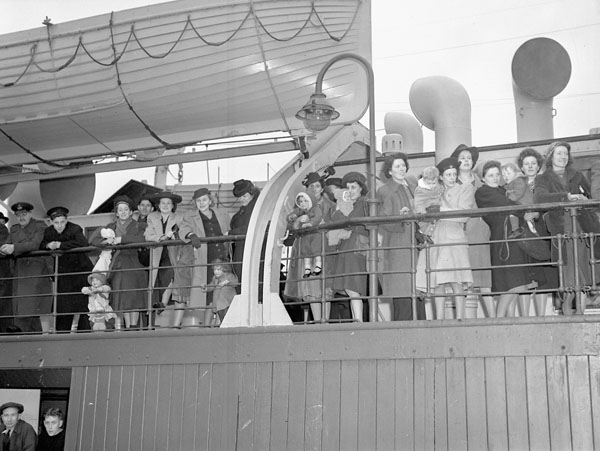
War brides and their children leave England for Canada on April 17, 1944.
The ocean liner SS Mauritania docked at Pier 21 in Halifax on Feb. 10, 1946, filled with women described in the media as homesick, seasick and lovesick.
War brides.
There were brides from every country where Canadians were deployed.
The vessel was the first of the bride ships, which by 1947 had carried more than 44,000 women and about 21,000 children to new lives in Canada.
During the war, brides could accompany husbands returning to Canada, but at the end of the war, all ships were needed to transport troops home, so the brides had to follow later.
The women were mostly British, but there were brides from every country where Canadians were deployed, including the Netherlands, Belgium, France, Italy and even Germany.
The Canadian Wives’ Bureau in London helped brides make arrangements to join their husbands. The Canadian government provided free passage across the Atlantic and, from there, war-bride trains to take them across the country.
A wave of weddings and baby showers followed across Canada and brides were introduced to their husbands’ families and their new communities.
Most were welcomed.
But life in postwar Canada was different from what they’d experienced or expected, despite government pamphlets and cookbooks meant to help them adapt.
There was a severe housing shortage at the time. Joyce (Gawn) Crane spent six weeks living with in-laws before her husband bought a farm in Hazelbrook, P.E.I. It was “a big old farmhouse with bare floorboards, no water, electricity in some rooms, a table, four chairs, a hot plate, a bed and a baby!”
Initially, they had to pump water in the barn and carry it to the house. They lived for 38 years “in the house that we had made home,” she said in a memoir on Veterans Affairs Canada’s remembrance website.
The government-issued tickets were one-way: brides who found themselves in dire straits were stuck in a strange country, sometimes without knowing the language, and without support of family and friends.
“We took an awful chance,” said Betty (Ackhurst) Hawkins in a Memory Project interview. “We really didn’t know these men all that well.”
Evelyn Fineberg from Northern Ireland found herself married to a man with “itchy feet who wanted to live in a suitcase. We never had any money,” she said in a 1982 CBC interview. Raising four daughters in poverty, her health broke down. During the year she spent in the hospital, her husband drowned, her house burned down and her children were placed in an orphanage.
Fineberg worked hard to make a life for them afterward, but some brides gave up and returned to their home countries. But most remained, helping to build the country after the war.
In 2000, a plaque was erected in their honour at Pier 21 and in 2006, the Year of the War Bride, a special celebration took place in Halifax to mark 60 years since the bride ships started arriving.
Advertisement


















